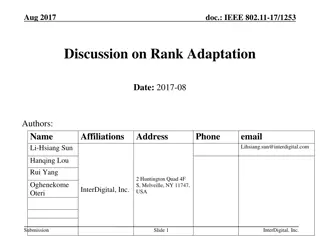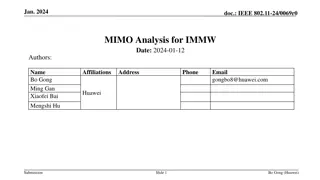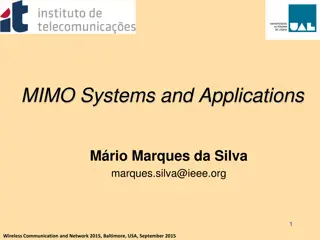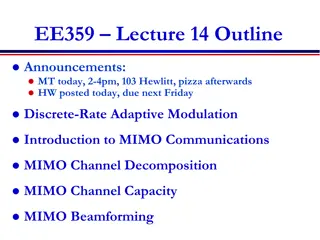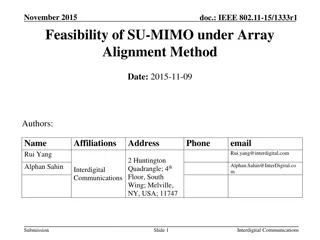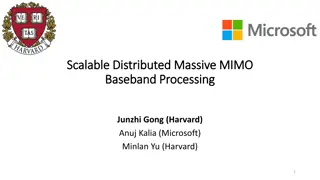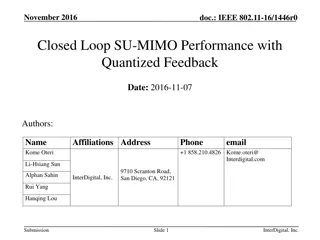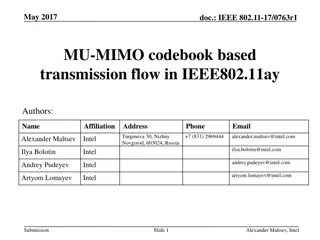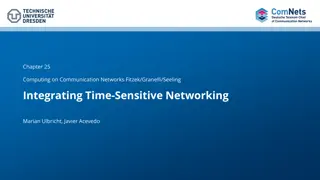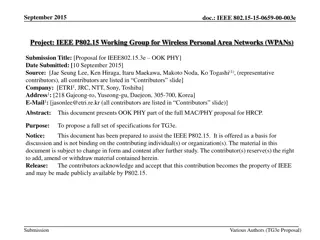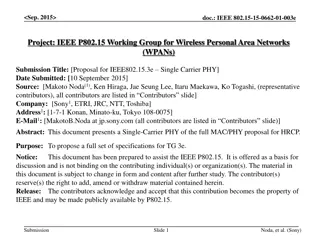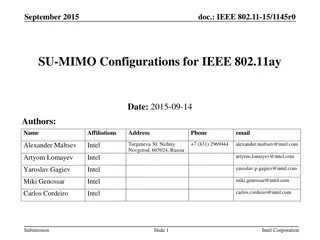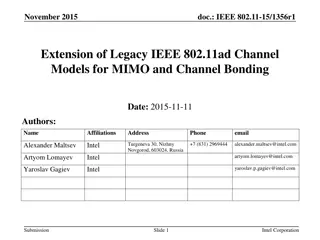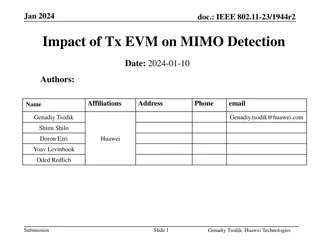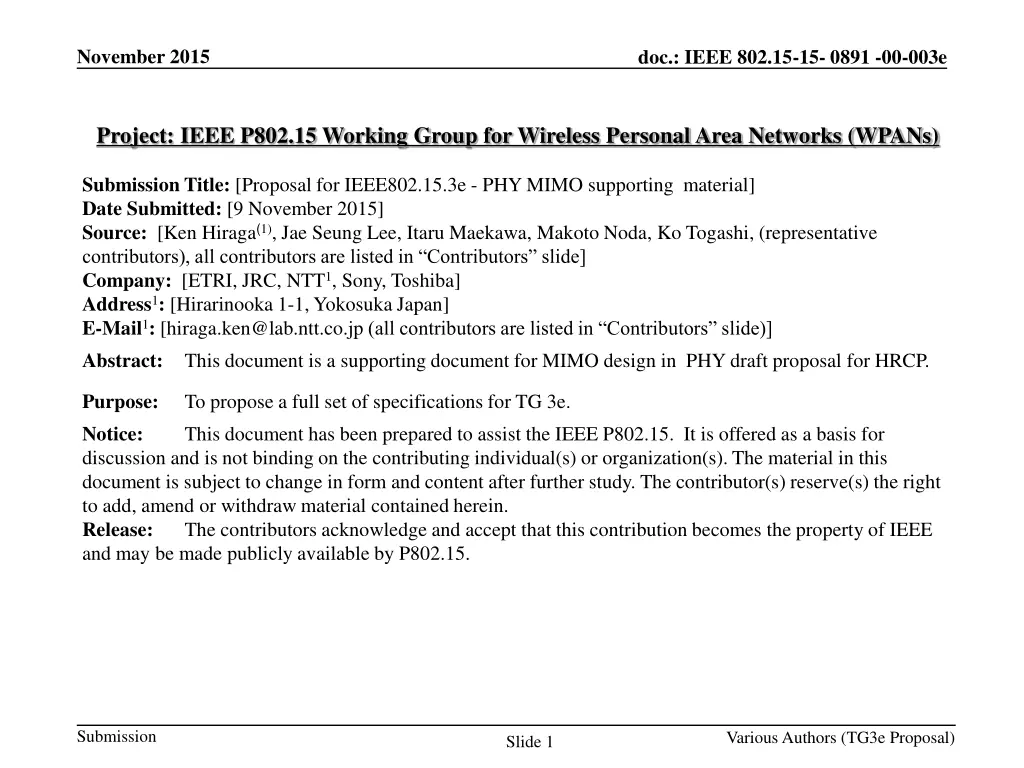
IEEE 802.15-15-0891-00-003e Proposal for PHY MIMO Support - November 2015
"Explore the IEEE 802.15-15-0891-00-003e proposal focusing on PHY MIMO support in wireless personal area networks (WPANs). The document outlines contributions, revisions to MCS table, and the use of M=9 over M=8 for better performance. Dive into details regarding transmission rates, modulation, BER, and channel capacity while considering MIMO design complexities."
Download Presentation

Please find below an Image/Link to download the presentation.
The content on the website is provided AS IS for your information and personal use only. It may not be sold, licensed, or shared on other websites without obtaining consent from the author. If you encounter any issues during the download, it is possible that the publisher has removed the file from their server.
You are allowed to download the files provided on this website for personal or commercial use, subject to the condition that they are used lawfully. All files are the property of their respective owners.
The content on the website is provided AS IS for your information and personal use only. It may not be sold, licensed, or shared on other websites without obtaining consent from the author.
E N D
Presentation Transcript
November 2015 doc.: IEEE 802.15-15- 0891 -00-003e Project: IEEE P802.15 Working Group for Wireless Personal Area Networks (WPANs) Submission Title: [Proposal for IEEE802.15.3e - PHY MIMO supporting material] Date Submitted: [9 November 2015] Source: [Ken Hiraga(1), Jae Seung Lee, Itaru Maekawa, Makoto Noda, Ko Togashi, (representative contributors), all contributors are listed in Contributors slide] Company: [ETRI, JRC, NTT1, Sony, Toshiba] Address1: [Hirarinooka 1-1, Yokosuka Japan] E-Mail1: [hiraga.ken@lab.ntt.co.jp (all contributors are listed in Contributors slide)] Abstract: This document is a supporting document for MIMO design in PHY draft proposal for HRCP. Purpose: Notice: discussion and is not binding on the contributing individual(s) or organization(s). The material in this document is subject to change in form and content after further study. The contributor(s) reserve(s) the right to add, amend or withdraw material contained herein. Release: The contributors acknowledge and accept that this contribution becomes the property of IEEE and may be made publicly available by P802.15. To propose a full set of specifications for TG 3e. This document has been prepared to assist the IEEE P802.15. It is offered as a basis for Submission Various Authors (TG3e Proposal) Slide 1
November 2015 doc.: IEEE 802.15-15- 0891 -00-003e Contributors Name Affiliation Email Jae Seung Lee ETRI jasonlee@etri.re.kr Moon-Sik Lee ETRI moonsiklee@etri.re.kr Itaru Maekawa Japan Radio Co., Ltd. maekawa.itaru@jrc.co.jp Doohwan Lee NTT Corporation lee.doohwan@lab.ntt.co.jp Ken Hiraga NTT Corporation hiraga.ken@lab.ntt.co.jp Hideki Toshinaga NTT Corporation toshinaga.hideki@lab.ntt.co.jp Masashi Shimizu NTT Corporation masashi.shimizu@upr-net.co.jp Keitarou Kondou Sony Corporation Keitarou.Kondou@jp.sony.com Hiroyuki Matsumura Sony Corporation Hiroyuki.Matsumura@jp.sony.com Makoto Noda Sony Corporation MakotoB.Noda at jp.sony.com Masashi Shinagawa Sony Corporation Masashi.Shinagawa@jp.sony.com Ko Togashi Toshiba Corporation ko.togashi@toshiba.co.jp Kiyoshi Toshimitsu Toshiba Corporation kiyoshi.toshimitsu@toshiba.co.jp Submission Various Authors (TG3e Proposal) Slide 2
November 2015 doc.: IEEE 802.15-15- 0891 -00-003e 1. 7/8 adds complexity and is not needed because rates are very close to 14/15. MCS table was revised: 7/8 MCS were removed. M = 9 is used instead of M = 8 M = 9 modes have better BER than M = 8. PHY transmission rate, Gbit/s SISO 2 x 2 4 x 4 9 x 9 16 x 16 without pilot word 25.9 52.6 40.7 82.6 51.7 105.1 61.0 123.9 108.4 77.6 157.7 138.0 Code Rate Modulation without pilot word with pilot word* without pilot word 2.9 4.5 5.7 6.8 8.6 with pilot word* without pilot word 5.7 9.0 11.5 13.6 17.2 with pilot word* without pilot word 29.6 46.5 59.1 69.7 88.7 with pilot word* with pilot word* 46.0 72.3 92.0 QPSK 16QAM 16QAM 64QAM 64QAM 14/15 11/15 14/15 11/15 14/15 3.3 5.2 6.6 7.7 9.9 6.6 10.3 13.1 15.5 19.7 13.1 20.7 26.3 31.0 39.4 11.5 18.1 23.0 27.1 34.5 Submission Various Authors (TG3e Proposal) Slide 3
November 2015 doc.: IEEE 802.15-15- 0891 -00-003e Proposal to use M=9 instead of M=8 M=8 M=9 1.E+00 1.E+00 1.E-01 1.E-01 1.E-02 1.E-02 1.E-03 1.E-03 BER BER 1.E-04 1.E-04 1.E-05 1.E-05 1.E-06 1.E-06 1.E-07 1.E-07 0 10 20 30 40 SNR[dB] 0 10 20 30 40 SNR[dB] When M=9, BER performance is better than M=8. 20 M=4 M=8(2x4array) M=9 M=16 Capacity / No. of branches 18 [bit/s/Hz/stream] 16 When M=9, (channel capacity / M) is higher than M=8. -> correlation is low 14 12 10 Pt/Noise = 80 dB 8 10 30 50 70 90 Transmission distance [mm] Submission Various Authors (TG3e Proposal) Slide 4
November 2015 doc.: IEEE 802.15-15- 0891 -00-003e Channel aggregation and bonding Frequency channels (same as 15.3c) Channel # Start frequency Center frequency Stop frequency 1 57.240 58.320 59.400 2 59.400 60.480 61.560 3 61.560 62.640 63.720 4 63.720 64.800 65.880 Channel aggregation 2 channels: Ch1+Ch2 Ch1+Ch3 Ch1+Ch4 Ch2+Ch3 Ch2+Ch4 Ch3+Ch4 3 channels:Ch1+Ch2+Ch3 Ch1+Ch2+Ch4 Ch1+Ch3+Ch4 Ch2+Ch3 + Ch4 4 channels:Ch1+Ch2+Ch3+Ch4 Channel bonding 2 channels: Ch2+Ch3 3 channels: Ch1+Ch2+Ch3 4 channels: Ch1+Ch2+Ch3+Ch4 Submission Various Authors (TG3e Proposal) Slide 5
November 2015 doc.: IEEE 802.15-15- 0891 -00-003e 2. Parallel preamble and SFD for all branches? Should we add cyclic shift delay? SYNC and SFD have to have cyclic shift delay in order to avoid the deep reception level depression due to canceling effect caused by the interelement spacing. DEV PPC If the same waveform is transmitted from all antennas Cancel each other when these path length difference is around half wavelength and causes deep depression in the reception level: Submission Various Authors (TG3e Proposal) Slide 6
November 2015 doc.: IEEE 802.15-15- 0891 -00-003e 2. Parallel preamble and SFD for all branches? Should we add cyclic shift delay? M - streams data Tx#1 CES Header #1 Payload #1 SYNC SFD Tx#2 CES Header #2 Payload #2 SYNC SFD Tx#3 SYNC SFD Header #3 Payload #3 CES Header #4 Payload #4 CES SYNC SFD Tx#4 The value of cyclic shift for i th transmitter TCSsfd_i= 4 * ( i 1 ) [ns]. The value of cyclic shift for i th transmitter TCSsync_i= 60 * ( i 1 ) [ns]. Submission Various Authors (TG3e Proposal) Slide 7
November 2015 doc.: IEEE 802.15-15- 0891 -00-003e CES structure Presented in Sep. meetings 0 values, unmodulated Tx#1 CES #1 Header #1 Payload #1 SYNC SFD Tx#2 SYNC SFD CES #2 Header #2 Payload #2 Tx#3 SYNC SFD CES #3 Header #3 Payload #3 Tx#4 SYNC SFD CES #4 Header #4 Payload #4 same in each antenna element for MIMO transmission channel estimation Proposal Tx#1 CES#1 Header #1 Payload #1 SYNC SFD Tx#2 CES#2 Header #2 Payload #2 SYNC SFD Tx#3 SYNC SFD Header #3 Payload #3 CES#3 Header #4 Payload #4 CES#4 SYNC SFD Tx#4 Golay sequences with cyclic shifts Submission Various Authors (TG3e Proposal) Slide 8
November 2015 doc.: IEEE 802.15-15- 0891 -00-003e CES structure M = 2, 4 72*8 = 576 chips = 327 ns Tx#i SFD# i CES# i Header # i Payload #i SYNC# i 72 * 8 repetitions 72 72 72 72 8 repetitions 72 8 chips CP inserted TCSces_i= 4.5* ( i 1 ) [ns] Cyclic shift 64 8 Time domain waveform 72 chips Ga64 = [-1 -1 +1 -1 +1 -1 -1 -1 +1 +1 -1 +1 +1 -1 -1 -1 -1 -1 +1 -1 +1 -1 -1 -1 -1 -1 +1 -1 -1 +1 +1 +1 -1 -1 +1 -1 +1 -1 -1 -1 +1 +1 -1 +1 +1 -1 -1 -1 +1 +1 -1 +1 -1 +1 +1 +1 +1 +1 -1 +1 +1 -1 -1 -1 ] IFFT Frequency domain Ga64 Submission Various Authors (TG3e Proposal) Slide 9
November 2015 doc.: IEEE 802.15-15- 0891 -00-003e CES structure M = 9, 16 72*4 = 288 chips =164 ns 164 ns Tx#i (i = 1 ~ 8) CES# i SFD# i Header # i Payload #i SYNC# i Tx#i (i = 9 ~ 16) CES# i SFD# i Header # i Payload #i SYNC# i 72 72 72 72 4 repetitions 72 8 chips CP inserted TCSces_i= 4.5* ( mod(i, 8) 1 ) [ns] Cyclic shift 64 8 Time domain waveform 72 chips Ga64 = [-1 -1 +1 -1 +1 -1 -1 -1 +1 +1 -1 +1 +1 -1 -1 -1 -1 -1 +1 -1 +1 -1 -1 -1 -1 -1 +1 -1 -1 +1 +1 +1 -1 -1 +1 -1 +1 -1 -1 -1 +1 +1 -1 +1 +1 -1 -1 -1 +1 +1 -1 +1 -1 +1 +1 +1 +1 +1 -1 +1 +1 -1 -1 -1 ] IFFT Frequency domain Ga64 Submission Various Authors (TG3e Proposal) Slide 10
November 2015 doc.: IEEE 802.15-15- 0891 -00-003e 3. When is stable position assumed? How to know when device is stable? DEV should start sending Array Training commands after DEV recognizes it is not moving around on the array surface of the PPC. The method for the recognition is up to implementation, for example Use of NFC signal detection Use of optical camera imaging Use of timer, assuming the user stabilizes the positions of DEV within a certain time (e.g. 2 sec). In draft, above is reflected in the description on the setup sequence. Submission Various Authors (TG3e Proposal) Slide 11
November 2015 4. What is the time interval of Association Request Commands? What is the duration of each Association Request Command? doc.: IEEE 802.15-15- 0891 -00-003e MIMO setup sequence is revised as shown in the next slide. Submission Various Authors (TG3e Proposal) Slide 12
November 2015 doc.: IEEE 802.15-15- 0891 -00-003e The number of antenna elements: Marray(1~ 511) The number of MIMO branches: M1 ( 1~16) The number of MIMO branches: M2 PPC (Kiosk) DEV(Portable terminal) SISO mode on Ch2 using the antenna element #1 SISO mode on Ch2 using the antenna element #1 Beacon Comprises information below: MIMO capability (M1) Value of Nar (No. of Array training commands. Nar= 0 ~ 511, Nar Marray) Value of Tar (Period of Array training commands, Channel Agg. capability Channel bond. capability Association (in SISO on ch2) decides the number of branches, M, (e.g. by determining M=min(M1,M2) . ) Channel bonding or aggregation is decided as well. Decision method is on implementations 10, 20, 40, or 80 ) Association request Comprises information below: Value of M as MIMO capability field A channel Agg. or bond. as capability field knows the number of MIMO branches to be used, M. and channel aggregation/bonding. For example, start receiving Array Training using antenna element which has sent Association response. Association response Switch to antenna selecting mode Ready to listen the Array training commands. Switch to antenna selecting mode (1) when M < Marray PPC selects M antennas (Example of procedure selecting antenna: Select using reception levels) Array training commands are sent Nartimes, hence Nar antennas are switched on to receive these commands. (2) when M = Marray PPC does not have to select antenna element. Detect that DEV is stable position or timeout (e.g. 2 sec) Array training #1 Remaining time = (Nar 1) Array training #2 Antenna Selecting Procedure (in SISO on ch2) Array training #Nar 1 The number of Antenna training commands sent here is equal to Nar. These are transmitted from antenna element #1 to allow PPC to select antenna elements for following MIMO transmission. While transmissions of these commands the remaining number is counted down. Array training commands #1 ~ #Nar 1 shall be No-ACK policy. Only the last Array training command shall be Stack-ACK policy. Array training #Nar The last Array training command received If ACK for Array training #Nar is not received by DEV, Array training #Nar shall be retransmitted. The reception antenna shall be changed into another one, and after retransmissions the reception antenna is set to an element that successfully received Array training command before #Nar. Ack Switch to M-stream MIMO mode (Antenna elements to be used are already selected) with channel aggrgation. or bonding. Switch to M-stream MIMO mode with channel aggregation. or bonding. agg./bond. MIMO PHY frames with MIMO channel agg./bond. and ch mode Submission Various Authors (TG3e Proposal) Slide 13
November 2015 doc.: IEEE 802.15-15- 0891 -00-003e 5. Total 5 dBm tx power for 16 antennas Reflected in the link budget table. Submission Various Authors (TG3e Proposal) Slide 14
November 2015 6. Link budget for all MIMO combinations, including channel aggregation. doc.: IEEE 802.15-15- 0891 -00-003e 6.1. Supporting material, specify all link budget This table shows the link budget per all combinations for frequency channel. Total transmission power should be multiplied by No. of channels. M=2 M=4 M=9 M=16 MCS and MIMO QPSK 14/15 16QAM 11/15 16QAM 14/15 64QAM 11/15 64QAM 14/15 QPSK 14/15 16QAM 11/15 16QAM 14/15 64QAM 11/15 64QAM 14/15 QPSK 14/15 16QAM 11/15 16QAM 14/15 64QAM 11/15 64QAM 14/15 QPSK 14/15 16QAM 11/15 16QAM 14/15 64QAM 11/15 64QAM 14/15 Moduation Code rate Required CNR for FER=8% (dB) Required Eb/N0 for FER=8% (dB) Average M Total Tx power level, Pt(dBm) per frequency channel Tx antenna gain, Gt (dBi) Implementation loss, IL (dB) Center frequency, fc (GHz) Transmission distance, D (mm) Transmission loss, PL (dB) Rx antenna gain, Gr (dBi) Thermal noise, Nth (dBm/Hz) Rx noise figure, NF (dB) Signal Bandwidth, BW GHz) Symbol rate, SymR (dBHz) Noise power level, NP(dBm) System margin, SysM (dB) Required Rx level, ReqRx (dBm) Allowable path loss, APL (dB) 2 0.9 19.0 16.3 4 0.7 18.0 13.3 4 0.9 23.0 17.3 6 0.7 24.0 17.6 6 0.9 30.0 22.5 2 0.9 19.0 16.3 4 0.7 21.0 16.3 4 0.9 24.0 18.3 6 0.7 26.0 19.6 6 0.9 30.0 22.5 2 0.9 21.0 18.3 4 0.7 33.0 28.3 4 0.9 26.0 20.3 6 0.7 28.0 21.6 6 0.9 33.0 25.5 2 0.9 23.0 20.3 4 0.7 24.0 19.3 4 0.9 29.0 23.3 6 0.7 31.0 24.6 6 0.9 37.0 29.5 -16.2 4.0 6.0 60.5 40.0 40.1 4.0 -173.8 -17.2 4.0 6.0 60.5 40.0 40.1 4.0 -173.8 -12.2 4.0 6.0 60.5 40.0 40.1 4.0 -173.8 -11.2 4.0 6.0 60.5 40.0 40.1 4.0 -173.8 -5.2 4.0 6.0 60.5 40.0 40.1 4.0 -173.8 -16.2 4.0 6.0 60.5 40.0 40.1 4.0 -173.8 -14.2 4.0 6.0 60.5 40.0 40.1 4.0 -173.8 -11.2 4.0 6.0 60.5 40.0 40.1 4.0 -173.8 -9.2 4.0 6.0 60.5 40.0 40.1 4.0 -173.8 -5.2 4.0 6.0 60.5 40.0 40.1 4.0 -173.8 -14.2 4.0 6.0 60.5 40.0 40.1 4.0 -173.8 -2.2 4.0 6.0 60.5 40.0 40.1 4.0 -173.8 -9.2 4.0 6.0 60.5 40.0 40.1 4.0 -173.8 -7.2 4.0 6.0 60.5 40.0 40.1 4.0 -173.8 -2.2 4.0 6.0 60.5 40.0 40.1 4.0 -12.2 4.0 6.0 60.5 40.0 40.1 4.0 -173.8 -11.2 4.0 6.0 60.5 40.0 40.1 4.0 -173.8 -6.2 4.0 6.0 60.5 40.0 40.1 4.0 -4.2 4.0 6.0 60.5 40.0 40.1 4.0 1.8 4.0 6.0 60.5 40.0 40.1 4.0 -173.8 Tx Channel -173.8 -173.8 -173.8 8.0 1.8 92.5 -73.3 0.0 -54.3 40.1 8.0 1.8 92.5 -73.3 0.0 -55.3 40.1 8.0 1.8 92.5 -73.3 0.0 -50.3 40.1 8.0 1.8 92.5 -73.3 0.0 -49.3 40.1 8.0 1.8 92.5 -73.3 0.0 -43.3 40.1 8.0 1.8 92.5 -73.3 0.0 -54.3 40.1 8.0 1.8 92.5 -73.3 0.0 -52.3 40.1 8.0 1.8 92.5 -73.3 0.0 -49.3 40.1 8.0 1.8 92.5 -73.3 0.0 -47.3 40.1 8.0 1.8 92.5 -73.3 0.0 -43.3 40.1 8.0 1.8 92.5 -73.3 0.0 -52.3 40.1 8.0 1.8 92.5 -73.3 0.0 -40.3 40.1 8.0 1.8 92.5 -73.3 0.0 -47.3 40.1 8.0 1.8 92.5 -73.3 0.0 -45.3 40.1 8.0 1.8 92.5 -73.3 0.0 -40.3 40.1 8.0 1.8 92.5 -73.3 0.0 -50.3 40.1 8.0 1.8 92.5 -73.3 0.0 -49.3 40.1 8.0 1.8 92.5 -73.3 0.0 -44.3 40.1 8.0 1.8 92.5 -73.3 0.0 -42.3 40.1 8.0 1.8 92.5 -73.3 0.0 -36.3 40.1 Rx Submission Various Authors (TG3e Proposal) Slide 15
November 2015 doc.: IEEE 802.15-15- 0891 -00-003e 6. Link budget for all MIMO combinations, including channel aggregation. 6.2. Draft material, EVM, min receive level Transmitter specification: Same as SISO mode as shown in 12a.2.4 Because each SISO signal stream is transmitted via each antenna. Min receive level: added on 12a.2.8.10 (next slide) Submission Various Authors (TG3e Proposal) Slide 16
November 2015 doc.: IEEE 802.15-15- 0891 -00-003e Min receive level MIMO Receiver sensitivity dBm MCS No. of branches QPSK, 14/15 16QAM, 11/15 16QAM, 14/15 64QAM, 11/15 64QAM, 14/15 QPSK, 14/15 16QAM, 11/15 16QAM, 14/15 64QAM, 11/15 64QAM, 14/15 QPSK, 14/15 16QAM, 11/15 16QAM, 14/15 64QAM, 11/15 64QAM, 14/15 QPSK, 14/15 16QAM, 11/15 16QAM, 14/15 64QAM, 11/15 64QAM, 14/15 -54 -55 -50 -49 -43 -54 -52 -49 -47 -43 -52 -40 -47 -45 -40 -50 -49 -44 -42 -36 2 2 2 2 2 4 4 4 4 4 9 9 9 9 9 16 16 16 16 16 Submission Various Authors (TG3e Proposal) Slide 17
November 2015 doc.: IEEE 802.15-15- 0891 -00-003e 7. Remove 20%? It should be remove 10% worst error results . To remove abnormal values, we use 10 % trim averaging in BER calculation using channel model. This is the same procedure as 15.3c criteria (15- 05-0493r27). Submission Various Authors (TG3e Proposal) Slide 18
November 2015 8. Specify data throughput from MAC to PHY across PHY SAP for MIMO doc.: IEEE 802.15-15- 0891 -00-003e 8.1. Supporting material Payload size (Octets) PHY-SAP bitrate [Gbps] No-ACK mode PHY-SAP bitrate [Gbps] Imm-ACK mode Period [nsec] M, Modulatio n bit/symbol MCS T_PA_I NITIAL T_PA_ CONT T_PHY HDR T_MA CHDR T_HCST_PAY T_FCST_MIF N (No. of frames) T_PAC KET T_OVH D (MIMO) Code rate T_SIFS LOAD S QPSK,14/15 QPSK,14/15 QPSK,14/15 QPSK,14/15 16QAM,11/15 16QAM,11/15 16QAM,11/15 16QAM,11/15 16QAM,14/15 16QAM,14/15 16QAM,14/15 16QAM,14/15 64QAM,11/15 64QAM,11/15 64QAM,11/15 64QAM,11/15 64QAM,14/15 64QAM,14/15 64QAM,14/15 64QAM,14/15 2 2 2 2 4 4 4 4 4 4 4 4 6 6 6 6 6 6 6 6 0.9 0.9 0.9 0.9 0.7 0.7 0.7 0.7 0.9 0.9 0.9 0.9 0.7 0.7 0.7 0.7 0.9 0.9 0.9 0.9 2 4 9 16384 16384 16384 16384 16384 16384 16384 16384 16384 16384 16384 16384 16384 16384 16384 16384 16384 16384 16384 16384 1854.5 1418.2 1854.5 1418.2 1854.5 1418.2 1854.5 1418.2 1854.5 1418.2 1854.5 1418.2 1854.5 1418.2 1854.5 1418.2 1854.5 1418.2 1854.5 1418.2 1854.5 1418.2 1854.5 1418.2 1854.5 1418.2 1854.5 1418.2 1854.5 1418.2 1854.5 1418.2 1854.5 1418.2 1854.5 1418.2 1854.5 1418.2 1854.5 1418.2 86.4 86.4 86.4 86.4 86.4 86.4 86.4 86.4 86.4 86.4 86.4 86.4 86.4 86.4 86.4 86.4 86.4 86.4 86.4 86.4 90 90 90 90 90 90 90 90 90 90 90 90 90 90 90 90 90 90 90 90 20 20 20 20 20 20 20 20 20 20 20 20 20 20 20 20 20 20 20 20 39896 39896 39896 39896 25388 25388 25388 25388 19948 19948 19948 19948 16926 16926 16926 16926 13299 13299 13299 13299 9.1 9.1 9.1 9.1 4.5 4.5 4.5 4.5 4.5 4.5 4.5 4.5 3.0 3.0 3.0 3.0 3.0 3.0 3.0 3.0 50 50 50 50 50 50 50 50 50 50 50 50 50 50 50 50 50 50 50 50 2500 2500 2500 2500 2500 2500 2500 2500 2500 2500 2500 2500 2500 2500 2500 2500 2500 2500 2500 2500 1 1 1 1 1 1 1 1 1 1 1 1 1 1 1 1 1 1 1 1 40102 40102 40102 40102 25589 4555.5 25589 4555.5 25589 4555.5 25589 4555.5 20149 4555.5 20149 4555.5 20149 4555.5 20149 4555.5 17125 4553.9 17125 4553.9 17125 4553.9 17125 4553.9 13498 4553.9 13498 4553.9 13498 4553.9 13498 4553.9 4560 4560 4560 4560 5.9 11.8 26.5 47.2 8.8 17.5 39.4 70.0 10.7 21.4 48.1 85.6 12.2 24.4 54.9 97.6 14.7 29.4 66.1 117.5 5.3 10.7 24.1 42.8 7.6 15.2 34.2 60.8 9.0 18.0 40.6 72.2 10.1 20.1 45.3 80.6 11.7 23.4 52.6 93.6 16 2 4 9 16 2 4 9 16 2 4 9 16 2 4 9 16 Submission Various Authors (TG3e Proposal) Slide 19
November 2015 8. Specify data throughput from MAC to PHY across PHY SAP for MIMO doc.: IEEE 802.15-15- 0891 -00-003e PHY-SAP Throughput for Imm-ACK mode (64QAM) 180.0 160.0 PHY-SAP throughput [Gbps] 140.0 MIMO spatial streams 120.0 2 4 9 16 100.0 80.0 60.0 40.0 20.0 0.0 100 1000 10000 Payload size (octets) 100000 1000000 10000000 Submission Various Authors (TG3e Proposal) Slide 20
November 2015 doc.: IEEE 802.15-15- 0891 -00-003e Thank you Submission Various Authors (TG3e Proposal) Slide 21



